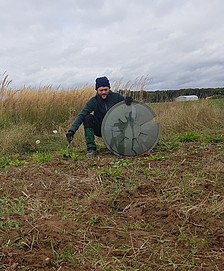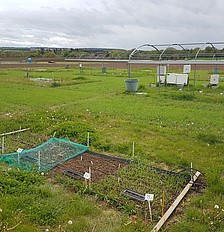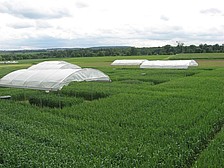Does microbial adaptation to future mean climatic conditions control the response of agroecosystems to severe drought events?
Vinzent Leyrer
Institute of Soil Science and Land Evaluation, Soil Biology
Challenges
Soil microorganisms are the driving force behind relevant biogeochemical cycles and thus soil ecosystem functions. The rate of microbially driven cycling processes and its involved species depend on water availability and temperature conditions (Zhang et al. 2019). Consequently, changing mean climatic conditions pose an evolutionary challenge for soil microorganisms as they must develop adaptation and survival strategies in order to optimize their resource use to ultimately survive in an evolving microenvironment (Cavicchioli et al. 2019). Besides undergoing changes in long-term mean climatic conditions, extreme events like drought spells are predicted to intensify in number and duration in the future (Grillakis 2019). Drought spells are a major threat for soil functional processes as water films in soil pores are microbial habitat as well as solvent and transport medium for microbial resources. Further, drought demands soil microorganisms for a reallocation of resources from growth to cell protective pathways with feedback mechanisms regarding carbon and nutrient cycling in soils (Schimel 2018). While it is of no doubt, that intensifying drought spells have profound effects on soil ecosystem processes, it is unclear, how the adaptation to changing mean climatic conditions influences the response of soil microorganisms to a drought spell.
Objectives
The overall aim of the project is to understand how the adaptation of the soil microbiome to future mean climatic conditions influences microbial driven soil processes during drought spells.
Specific objects are:
- to quantify overall microbial abundance and to characterize its community structure within the phase of before the drought spell, during drought, and after rewetting.
- to identify changes in soil carbon and nitrogen cycling during and after a drought spell which are linked to a functional shift based on altered enzyme and respiration activity of a soil microbiome which is adapted to future mean climatic conditions.
Expected results
Microbial adaptation to intensifying climatic conditions is expected to have a ‘legacy effect’ on microbial organismal and functional response to an extreme event, in this case a drought spell. In detail, based on previous indications, microbial adaptation to drier conditions (i.e. reduced precipitation, elevated temperature) will promote fungal abundance with high ability to resist, hence remaining metabolically active, during drought. Further, microbial adaptation may include higher potential extracellular enzyme activity, facilitating microbes with resources for adaptation mechanisms. Consequently, gas flux dynamics during drought and after rewetting will change based on previous mentioned microbial adaptation processes. Overall, we expect this project to show that climatic condition induced legacy effects may be a major factor in soil ecosystem functioning under climate change.
Methods
As our research platform, we use the “Hohenheim Climate Chance Experiment (HoCC)”, which is located on an arable field of the experimental station Heidfeldhof. Mean precipitation and temperature patterns are manipulated since 2008. The simulated changes are based on climate change predictions for Germany (Umweltbundesamt 2006). The soil is heated with heating cables placed on the soil surface by 2.5 °C (temperature measurement at 4 cm soil depth). Precipitation is manipulated from June to August by either reducing the total precipitation amount (by 25%), the precipitation frequency (every second event gets applied cumulatively), or both, in a combined treatment.
The HoCC experiment was modified by exposing the whole system to an extreme event, a drought spell of four weeks in June 2019. Five timepoints (TP) for soil sampling have been selected which cover the three phases of a drought spell:
- before the drought spell (1 TP)
- just before the end of the drought spell (1 TP)
- after rewetting the soil (one, five and 14 days; 3 TP)
Analysis is divided into organismal and functional parameters. Besides overall microbial abundance, ergosterol, a biomarker for fungal biomass is measured, to capture organismal shifts as a consequence of microbial adaptation to drier conditions. In terms of functional shifts following microbial adaptation, analysis of extracellular enzyme activity within the C (β-glucosidase) , N (L-leucine-aminopeptidase; N-acetylglucosaminidase), and P (phosphatase) cycle is conducted. In combination with the pool sizes of labile C and inorganic N, resulting gas fluxes from soil (CO2 and N2O) during drought and after rewetting are analyzed via closed chambers, carried out on the field.
References
Schimel JP (2018). Life in Dry Soils: Effects of Drought on Soil Microbial Communities and Processes. Annu. Rev. Ecol. Evol. Syst. 49(1):409–432. doi:10.1146/annurev-ecolsys-110617-062614
Zhang S, Zheng Q, Noll L, Hu Y, Wanek W (2019). Environmental effects on soil microbial nitrogen use efficiency are controlled by allocation of organic nitrogen to microbial growth and regulate gross N mineralization. Soil biology & biochemistry 135:304–315. doi:10.1016/j.soilbio.2019.05.019




